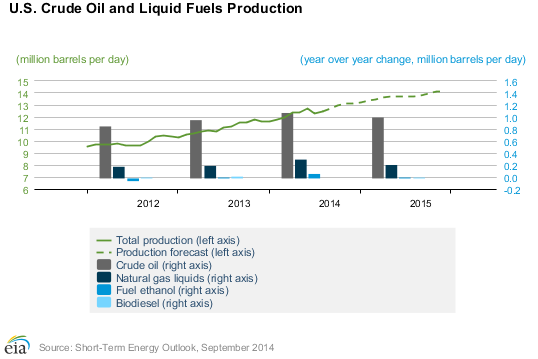SOURCE: U.S. Energy Information Administraton
‘So there will be weeping and gnashing of teeth’ the parable of the weeds goes in Matthew 13:42. No, this is not a Bible lesson nor am I suggesting a revelation about the future direction of oil prices. But it always surprises me when there is so much angst when oil prices fall as if there is some immutable law of nature that sways oil prices to only go up and never down.
The current condition is caused by several market factors including the continued growth of domestic onshore oil production in the United States, the strengthening of the U.S. dollar, good luck from Middle East oil producers and soft global demand. Not even the craziness of the violence in the Middle East has been enough to cause oil prices to spike as conventional wisdom suggested they would.
The U.S. Energy Information Administration’s (U.S. EIA) newly released Short Term Energy Outlook says total U.S. crude oil production averaged 8.6 million barrels per day (bbl/d) in August, the most since July 1986. Total crude oil production, which averaged 7.5 million bbl/d in 2013 and is expected to grow to an average 9.5 million bbl/d in 2015. This estimate of production growth is 0.2 million bbl/d higher than U.S. EIA projected last month. That 2015 forecast, if realized, would be the highest annual average U.S. crude oil production since 1970.
The result is the fear factor that usually sends oil pricing soaring when uncertainty rises up failed to materialize, at least over the last quarter or so. This is remarkable and signals something fundamental—supply and demand is alive and well even in the world oil market.
Here’s my ‘elevator explanation’ of what is happening: While the violence in the Middle East and elsewhere would historically trigger fears of supply disruption that would send oil prices skyrocketing, the growth in oil supply production in the United States from the shale revolution combined with the unexpected ability of the Libyans and Iraqis to bring oil to market eased the fear. Even if Libya and Iraq fell short there still would be still be enough oil given the combined efforts of Saudi Arabia, the traditional supplier of last resort, and the United States, the new supplier of last resort. So chill out everything will be alright.
Here are the facts:
- NYMEX light sweet crude oil prices fell in the third quarter by 12.15% and 2014 year to date are down 2.98%. Credit this to the U.S. shale revolution increasing U.S. oil supply most of which is that light sweet crude. Also factored in was improvement in oil pipeline infrastructure to ease the congestion at Cushing, Oklahoma. But don’t tell President Obama that was caused by the U.S. portion of the Keystone XL project and other projects that improved the probability that U.S. oil would get to market. That helped close the the WTI-Brent price spread, the market estimate of U.S. oil’s ability to get to market to compete with Brent oil which typically set the global oil price peg.
- Brent crude oil prices, the world oil benchmark price, fell third quarter by 14.43% and 2014 year to date are down 11.43%. This narrowed the WTI-Brent price difference, the closely watched benchmark for how competitive the U.S. is in world oil markets. So close is good in price differences. Fear of supply disruptions is easing as you can tell from comparing current oil prices to the traded range of oil prices so far in 2014 of $95.60 to $115.71. That’s while lower oil prices heading toward the $95.60 floor price is closely watched. The combination of lower oil demand lowering price expectations, plenty of supply and lower fears of supply disruption and a stronger U.S. dollar all conspire to change the world’s global economic perspective.
- The US dollar is stronger. This is a subjective and relative thing. The facts are the market perception is the U.S. economy is in better shape than EU markets where recession looms again, and China where plenty of potholes in the economy are making it much more difficult to manage a soft landing than the market expected. This is hardly praise for U.S. economic, tax, trade or foreign affairs policies, but suggests the market report card is the U.S. is doing ‘less bad’ than the rest of the world and we are still pumping out the oil. Since oil is traded in U.S. dollars a stronger dollar has the delightfully perverse effect of ‘sticking it to the bullies in global neighborhoods’ dependent upon increasing oil sales volume to fund their economies and their mischief.
I know President Obama does not want to hear this, but U.S. oil production growth is helping him out a lot just when he needs it most. It has saved him from a lot of weeping and gnashing of teeth from the fear, uncertainty and doubt (FUD) market impact of oil and thus ugly gasoline price spikes before the 2014 midterm election ‘throwing [the weeds of his policies] into the furnace of [economic] fire.’ OK that’s enough ‘snarky’ editorial comments—the truth is the combination of more U.S. oil production growth to come through the rest of his administration and a stronger dollar gives President Obama a much stronger hand to play with Russia, Iran and others if he chooses to use it.
Enjoy this economic capital gain while it lasts—like political capital it must be spent to do the most good.

